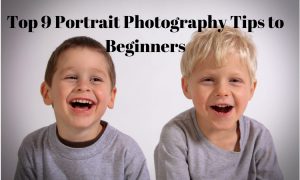Top 9 Portrait Photography Tips for Beginners

Why is it that your portraits are no match for the ones that come in the magazines? Is it that some models have much more photogenic faces than others?
This isn’t the case.
Anyone can look ‘photogenic’, it’s the way the photo is taken that makes the biggest difference. Any regular Jane can look gorgeous with the right amount of lighting, right pose, right location and the right camera aperture.
The best part is, anyone can take amazing photos with any regular DSLR camera by just keeping in mind the below mentioned tips.
Find below the top 9 Portrait Photography Tips for beginners:
-
Understanding your subject
To ensure that your subject looks photogenic, you need to understand him/her better. You need to connect with the subject to understand his/her likes, dislikes, their interests, their expectations from the photographs and so on. You can incorporate their favourite colour, pose or look into their photograph by understanding why they like it. Your main aim should be that the subject should be comfortable and relaxed while you are taking their photographs.
You can also go through your subjects previous photos, to understand how other photographers have captured him/her, how they have highlighted his/her features. You can then plan taking a much better photo based on what others have left out and what can be captured.
-
Choosing the right location
The choice of location depends on what the subject wants- if it is an outdoor shoot, you need to understand the light and the environment in which the shooting is to be done. If the shoot is done indoors, you have the option to control the lighting and environment, but a little know-how is needed to handle the various lighting and other equipment.
Anyways, if you are opting for an outdoor shoot, it is preferable to time it early in the morning or in the afternoon, so that you can take full advantage of the light during this time.
Although you can make changes with the lighting once the photograph is taken, it saves a lot of time if you take the photo in the right conditions.
-
Using the right props
A right prop complements the whole idea of the image. Many professional photographers use a wide array of props- anything from Styrofoam sheets, flashlights, various garments and many others to create a truly mesmerising image that will create a lasting impression on the viewer.
Some professionals do the exact opposite, use props to create a contrast for the underlying theme of the image, this gives a balanced view to the viewer. Whatever you decide, you should decide on the props based on a concept that should stick for the image.
-
Clicking the best shot from the best angle
A photo with a single angle becomes too generic. Choosing the right angle gives the photo a sense of persona and kitsch to the photo. It makes an otherwise normal individual an interesting person. The camera should be held to an eye to eye level, to get the best angle and deep meaning from the photograph. You can also shift your focus on other features like the lips, nose or face by choosing the right angle and zooming the camera accordingly.
-
Focusing on the eyes
For a portrait image, the first thing that captures the viewers attention is the eyes. These ‘windows of the soul’ need to be taken into consideration every time you click a photo, you can use many handy features of your camera to do this. For example, Sony Mirror less cameras have a feature called Eye AF that helps you to track focus on the eye. This can give you a sharp image no matter how shallow the depth of the field is.
-
Using the right lens
You need to understand that taking a portrait picture effectively means showing a three dimensional image on a flat plane-whatever is closest to the camera will appear largest in the picture.
Using the right lens, you need to ensure that the camera is positioned properly to hide the subjects’ features that you wouldn’t want to highlight- pronounced noses, heavy brows, double chins and so on. Choosing the right lens along with the right positioning of the camera makes all the difference. You can refer to your camera’s user manual to help you understand which lens is best in which conditions
-
Let your camera do some of the work
Shooting indoors in a controlled environment is one thing, where you can control every aspect of the image, but outdoors anything can change anytime. Here, using your camera’s built in metering system can help you a lot, you just need to understand its features thoroughly so that it can be used for the maximum impact.
-
Don’t depend solely on your camera’s features
On the flipside, you cannot solely depend on your camera’s default settings. There are many aspects of the environment that can change quickly, fooling your camera’s default settings- there can be changes in lighting environment, clouds may suddenly appear and so on. You need to be aware of these changes and make the necessary amends in your camera or the environment before shooting for the image.
-
Keeping it simple
Every seasoned photographer will swear by a simple rule-K.I.S.S Keep It Simple Stupid. With a photograph you can highlight only a single feature, you should aim to do that at all costs. If you try to put too many subjects or too many props in a single picture, it will spoil the entire photograph. If you cannot find an interesting background or prophylaxis, you can still make your subject the centre of all attention.
In the end, if you have taken the photograph and are still not sure about its look, you can avail our portrait photo retouching services at which can make your photo look just like a professionally shot one.

















